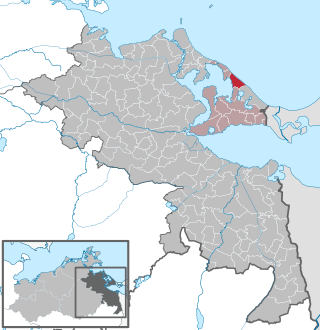
Usedom is a Baltic Sea island in Pomerania, divided between Germany and Poland. It is the second largest Pomeranian island after Rügen, and the most populous island in the Baltic Sea.
A seaside resort is a city, town, village, or hotel that serves as a vacation resort and is located on a coast. Sometimes the concept includes an aspect of official accreditation based on the satisfaction of certain requirements, such as in the German Seebad. Where a beach is the primary focus for tourists, it may be called a beach resort.

Zempin is a German municipality and the smallest seaside resort on Usedom island. It lies between Zinnowitz and Koserow on the narrowest part of the island, between the Baltic Sea and the Achterwasser, a bay of the Oder Lagoon.

Zinnowitz is a semi-urban Spa (resort) municipality in Mecklenburg-Vorpommern on the northern German island of Usedom on the Baltic Sea. The municipality has rail connections to Wolgast and Ahlbeck.

Heringsdorf is a semi-urban municipality and a popular seaside resort on Usedom Island in Western Pomerania, Germany. It is also known by the name Kaiserbad.

Ahlbeck is a village (Ortsteil) of the Heringsdorf municipality on the island of Usedom on the Baltic coast. It is the easternmost of the so-called Kaiserbäder seaside resorts on the German part of the island, situated right next to the border with Poland and the city of Świnoujście. Both communities are freely connected by the longest beach promenade in Europe spanning more than 12 km (7 mi) from Bansin to Świnoujście.

Bansin forms the westernmost part of the seaside resort town of Heringsdorf in Mecklenburg-Western Pomerania, Germany, on the east coast of Usedom island, about five miles by rail northwest of Świnoujście. Bansin is one of the most popular resorts on the German Baltic shore as part of the Heringsdorf municipality.

Usedom is a town on Usedom Island, in the Vorpommern-Greifswald district in Mecklenburg-Vorpommern, in north-eastern Germany, close to the border with Poland. It is the seat of the Amt Usedom-Süd, to which 14 other communities also belong.

Kühlungsborn is a Seebad town in the Rostock district, in Mecklenburg-Vorpommern, Germany. It is situated on the Baltic Sea coast, 11 km northwest of Bad Doberan, and 25 km northwest of Rostock.

Binz is the largest seaside resort city on the German island of Rügen.

Ückeritz is a municipality in the Vorpommern-Greifswald district, in Mecklenburg-Vorpommern, Germany.

Pudagla is a municipality in the Vorpommern-Greifswald district, in Mecklenburg-Vorpommern, Germany.

Loddin is a municipality on Usedom Island, in the Vorpommern-Greifswald district, in Mecklenburg-Vorpommern, Germany.

Sellin is a municipality on the Island of Rügen, in Mecklenburg-Vorpommern, Germany.

The Usedom Island Nature Park comprises the German part of the island of Usedom in the district of Vorpommern-Greifswald in the state of Mecklenburg-Vorpommern, Germany. In addition to the island itself, the park covers the waterbody between the island and the mainland as well as small strips of mainland in the northwest and west near the seaside resorts of Lubmin and the town of Lassan.

The Streckelsberg is an approximately 58-metre high coastal cliff on the island of Usedom in North Germany. After the Golm and the Kückelsberg, the Streckelsberg is the third highest elevation on the island. The Streckelsberg is located half a kilometre southeast of the former fishing village and present-day seaside resort of Koserow directly on the Baltic Sea shore. To the southeast is the village of Kölpinsee; the B 111 federal road and Usedomer Bäderbahn railway run past the hill to the southwest.

Resort architecture is an architectural style that is especially characteristic of spas and seaside resorts on the German Baltic coast. The style evolved since the foundation of Heiligendamm in 1793, and flourished especially around the year 1870, when resorts were connected to big cities via railway lines. Until today, many buildings on the German coasts are built in the style or feature distinct elements of resort architecture.

The Balmer See is the southeastern embayment of the Achterwasser on the island of Usedom off Germany's Baltic coast. The northwestern tongue of land, Cosim, together with the two small islets of Böhmke and Werder are designated as a nature reserve and bird sanctuary. To the south is the only golf course on the island - with 27 holes and 120 hectares in area. To the east are the two small villages of Balm and Neppermin ; the bay between Neppermin and the Schwedenschanze to the north is called Nepperminer See.

The Amber Spas are four German seaside resorts on the island of Usedom, that originally formed an administrative unit called Amt Insel Usedom-Mitte:


























